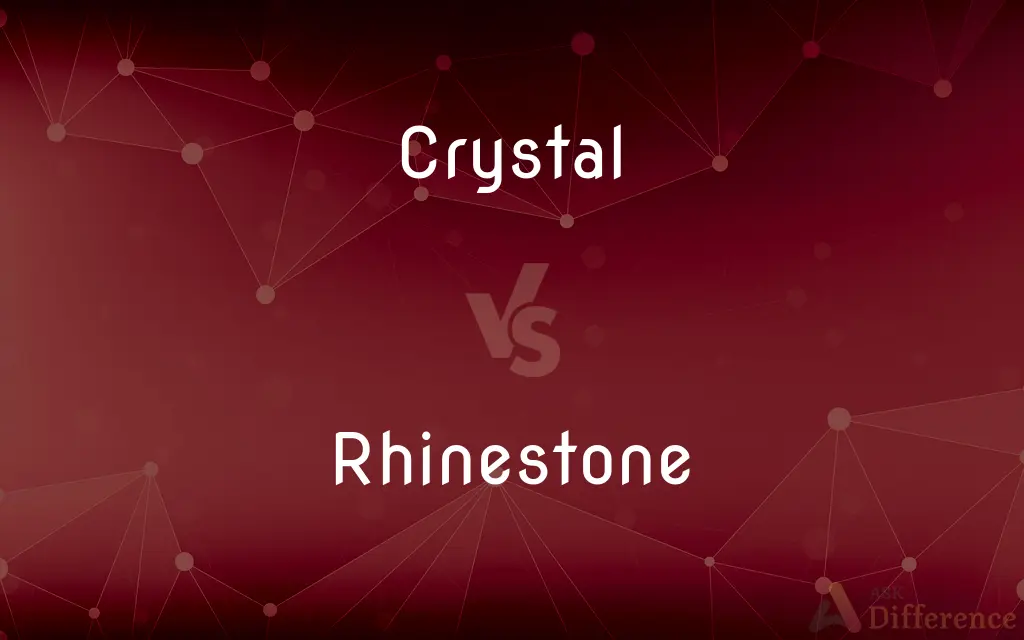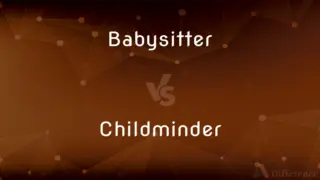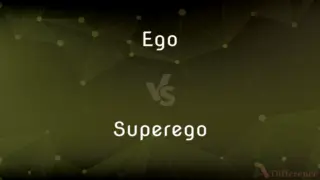Crystal vs. Rhinestone — What's the Difference?
By Tayyaba Rehman & Urooj Arif — Updated on March 21, 2024
Crystals are natural or synthetic minerals known for clarity and brilliance, while rhinestones are glass or acrylic gems, often lead glass, imitating diamonds.

Difference Between Crystal and Rhinestone
Table of Contents
ADVERTISEMENT
Key Differences
Crystals, either natural or synthetically produced, are known for their clarity, natural beauty, and often, metaphysical properties. On the other hand, rhinestones are specifically crafted to mimic the appearance of diamonds or other precious gems, primarily using lead glass or acrylic materials to enhance their reflective qualities.
While crystals can be found in various forms in nature, such as quartz or diamonds, and have a unique, often hexagonal, molecular structure, rhinestones are manufactured through a process that involves cutting and polishing glass or plastic to create facets that simulate the brilliance of true gemstones.
Crystals are valued for their rarity, unique properties, and the intricate processes through which they are formed naturally or created in a lab. In contrast, rhinestones are appreciated for their affordability and ability to provide a diamond-like sparkle without the high cost, making them popular in fashion and costume jewelry.
The clarity and brilliance of a crystal are determined by its purity and the precision of its cut, which can affect its value significantly. Conversely, the quality of a rhinestone is largely influenced by the materials used and the craftsmanship in cutting and backing the stone to enhance its reflective properties.
Crystals have diverse applications beyond jewelry, including technological and healing uses due to their piezoelectric properties and energy conduction. Rhinestones, while mainly used in decorative contexts like jewelry, clothing, and accessories, do not possess such functional properties and are valued purely for their aesthetic appeal.
ADVERTISEMENT
Comparison Chart
Composition
Natural or synthetic minerals
Glass, acrylic, or lead glass
Origin
Naturally occurring or lab-grown
Manufactured
Properties
Clarity, natural beauty, piezoelectric
Designed to mimic diamonds' sparkle
Uses
Jewelry, technology, healing
Fashion jewelry, decoration
Value Determinants
Rarity, purity, cut
Material quality, craftsmanship
Reflective Qualities
Natural brilliance
Enhanced by faceting and backing
Rarity
Varies widely
Widely available
Molecular Structure
Often hexagonal
No definitive structure, varies with material
Compare with Definitions
Crystal
Crystals are solid materials with naturally occurring or synthetically designed, highly ordered molecular structures.
Quartz crystals are often used in watches due to their precise oscillation rates.
Rhinestone
Rhinestones are imitation gemstones made from glass, acrylic, or lead glass designed to mimic diamonds.
Rhinestones are commonly used to add sparkle to costumes and accessories.
Crystal
Synthetic crystals are created in labs to mimic the properties of natural crystals.
Synthetic sapphire is used for durable watch faces.
Rhinestone
Lead glass rhinestones, known as crystal rhinestones, offer higher clarity and brilliance.
Crystal rhinestones are favored for their diamond-like shine in fashion jewelry.
Crystal
Natural crystals are prized for their rarity and unique metaphysical properties.
Amethyst crystals are popular in jewelry and for their purported healing qualities.
Rhinestone
Rhinestones are cut into facets to maximize light reflection and mimic the sparkle of real gemstones.
The precise faceting of rhinestones enhances their sparkle under lights.
Crystal
The value of a crystal is often linked to its clarity, color, and cut.
The clearer and more brilliantly cut a diamond, the higher its value.
Rhinestone
The quality of a rhinestone is determined by the material and the precision of the cut.
High-quality rhinestones can closely simulate the appearance of genuine diamonds.
Crystal
Crystals can have piezoelectric properties, making them useful in electronic devices.
Piezoelectric crystals are key components in ultrasound machines.
Rhinestone
They are popular in fashion due to their affordability and decorative appeal.
Rhinestones are often used on dance costumes for their eye-catching glitter.
Crystal
A crystal or crystalline solid is a solid material whose constituents (such as atoms, molecules, or ions) are arranged in a highly ordered microscopic structure, forming a crystal lattice that extends in all directions. In addition, macroscopic single crystals are usually identifiable by their geometrical shape, consisting of flat faces with specific, characteristic orientations.
Rhinestone
A rhinestone, paste or diamante is a diamond simulant originally made from rock crystal but since the 19th century from crystal glass or polymers such as acrylic.
Crystal
A piece of a homogeneous solid substance having a natural geometrically regular form with symmetrically arranged plane faces
Ice crystals formed where his breath froze
A quartz crystal
Rhinestone
A usually colorless artificial gem of crystal, glass, or another material, often with a flat metallic backing to create sparkling facets on the front.
Crystal
Highly transparent glass with a high refractive index
A crystal chandelier
Rhinestone
An artificial diamond, strass.
Lucinda sewed rhinestones into her scarf to add a bit of flair.
Crystal
Short for crystal meth (methamphetamine)
Rhinestone
Made of or encrusted with rhinestones.
Karl wore a cowboy hat with a rhinestone hatband when he played his country and western gigs.
Crystal
Clear and transparent like crystal
The clean crystal waters of the lake
Rhinestone
A colorless stone of high luster, made of paste. It is much used as an inexpensive ornament.
Crystal
A homogenous solid formed by a repeating, three-dimensional pattern of atoms, ions, or molecules and having fixed distances between constituent parts.
Rhinestone
An imitation diamond made from rock crystal or glass or paste
Crystal
The unit cell of such a pattern.
Crystal
A mineral, especially a transparent form of quartz, having a crystalline structure, often characterized by external planar faces.
Crystal
A natural or synthetic crystalline material having piezoelectric or semiconducting properties.
Crystal
An electrical or electronic device that makes use of such a material, thereby allowing it to receive radio transmissions.
Crystal
A high-quality, clear, colorless glass.
Crystal
An object, especially a vessel or ornament, made of such glass.
Crystal
Such objects considered as a group.
Crystal
A clear glass or plastic protective cover for the face of a watch or clock.
Crystal
(Slang) A stimulant drug, usually methamphetamine, in its powdered form.
Crystal
Clear or transparent
A crystal lake.
The crystal clarity of their reasoning.
Crystal
(countable) A solid composed of an array of atoms or molecules possessing long-range order and arranged in a pattern which is periodic in three dimensions.
Crystal
(countable) A piece of glimmering, shining mineral resembling ice or glass.
Crystal
(uncountable) A fine type of glassware, or the material used to make it.
Crystal
Crystal meth: methamphetamine hydrochloride.
Crystal
A person's eye.
Crystal
The glass over the dial of a watch case.
Crystal
Very clear.
"Do I make myself clear?" / "Crystal."
Crystal
The regular form which a substance tends to assume in solidifying, through the inherent power of cohesive attraction. It is bounded by plane surfaces, symmetrically arranged, and each species of crystal has fixed axial ratios. See Crystallization.
Crystal
The material of quartz, in crystallization transparent or nearly so, and either colorless or slightly tinged with gray, or the like; - called also rock crystal. Ornamental vessels are made of it. Cf. Smoky quartz, Pebble; also Brazilian pebble, under Brazilian.
Crystal
A species of glass, more perfect in its composition and manufacture than common glass, and often cut into ornamental forms. See Flint glass.
Crystal
The glass over the dial of a watch case.
Crystal
Anything resembling crystal, as clear water, etc.
The blue crystal of the seas.
Crystal
Consisting of, or like, crystal; clear; transparent; lucid; pellucid; crystalline.
Through crystal walls each little mote will peep.
By crystal streams that murmur through the meads.
The crystal pellets at the touch congeal,And from the ground rebounds the ratting hail.
Crystal
A solid formed by the solidification of a chemical and having a highly regular atomic structure
Crystal
A crystalline element used as a component in various electronic devices
Crystal
A rock formed by the solidification of a substance; has regularly repeating internal structure; external plane faces
Crystal
Colorless glass made of almost pure silica
Crystal
Glassware made of quartz
Crystal
A protective cover that protects the face of a watch
Common Curiosities
What is a crystal?
A crystal is a solid material whose atoms are arranged in a highly ordered, repeating pattern extending in all three spatial dimensions, found in nature or synthetically made.
Can crystals be synthetic?
Yes, crystals can be synthetically grown in labs to have the same physical and chemical properties as natural crystals.
What is a rhinestone?
A rhinestone is an imitation gemstone made from glass, acrylic, or lead glass, crafted to simulate the look of a diamond or other precious gems.
Why are rhinestones called so?
Rhinestones were originally named after the Rhine River, where rock crystals were gathered and used similarly before the advent of glass imitations.
What makes rhinestones sparkle?
Rhinestones sparkle due to their faceted surfaces that reflect and refract light, and sometimes a foil backing that enhances this effect.
Are all crystals valuable?
The value of crystals varies widely based on their type, rarity, purity, and how they are cut and polished.
Do rhinestones come in different colors?
Yes, rhinestones can be made in a wide range of colors to mimic different gemstones or achieve specific design effects.
What factors affect the quality of a crystal?
Factors like clarity, color, cut, and the presence of imperfections can affect a crystal's quality and value.
Why might someone choose rhinestones over real crystals or gems?
Rhinestones offer a cost-effective alternative to real gems, providing a similar aesthetic appeal without the high price tag.
Can you tell the difference between a crystal and a rhinestone?
Experts can distinguish between the two by examining their composition, clarity, cut, and the way they reflect light.
How are crystals formed?
Crystals are formed naturally through geological processes or created in a lab through controlled conditions that replicate natural growth.
What are the healing properties of crystals?
Some believe that crystals have healing properties related to energy and vibrational frequencies, though these claims are not scientifically proven.
Are rhinestones environmentally friendly?
The environmental impact of rhinestones depends on the materials used and the manufacturing process, with some materials being more eco-friendly than others.
How are rhinestones used in fashion?
Rhinestones are used in fashion as decorative elements on clothing, jewelry, and accessories to add sparkle and visual interest.
What are piezoelectric crystals?
Piezoelectric crystals generate an electric charge in response to mechanical stress and are used in various electronic devices.
Share Your Discovery

Previous Comparison
Babysitter vs. Childminder
Next Comparison
Ego vs. SuperegoAuthor Spotlight
Written by
Tayyaba RehmanTayyaba Rehman is a distinguished writer, currently serving as a primary contributor to askdifference.com. As a researcher in semantics and etymology, Tayyaba's passion for the complexity of languages and their distinctions has found a perfect home on the platform. Tayyaba delves into the intricacies of language, distinguishing between commonly confused words and phrases, thereby providing clarity for readers worldwide.
Co-written by
Urooj ArifUrooj is a skilled content writer at Ask Difference, known for her exceptional ability to simplify complex topics into engaging and informative content. With a passion for research and a flair for clear, concise writing, she consistently delivers articles that resonate with our diverse audience.














































